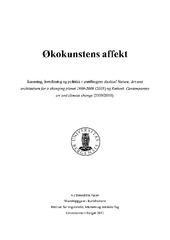Økokunstens affekt: Sansning, fortolkning og politikk i utstillingene Radical Nature. Art and architecture for a changing planet 1969-2009 (2009) og Rethink. Contemporary art and climate change (2009/2010)
Master thesis
Permanent lenke
https://hdl.handle.net/1956/4869Utgivelsesdato
2011Metadata
Vis full innførselSamlinger
Sammendrag
The increasing interest in ecological issues in the last decades has also manifested itself in the contemporary art field, visible by the large amount of thematic exhibitions in recent years; with nature, ecology and our relationship to the environment as key issues. Two recent exhibitions are Radical Nature. Art and architecture for a changing planet 1969-2009 (Barbican Art Gallery, 2009) and Rethink. Contemporary art and climate change (Stavanger Art Museum, 2010). Both exhibitions aim to make the viewer consider her own relationship to her surroundings. In this thesis I use these two exhibitions to raise questions as to how one can talk about such exhibitions effect on its audience. To do this I examine how the viewer may approach these exhibitions for them to have an effect. Thus, the thesis will revolve around how the viewer can search for the art works' signification through active interpretation, and examine what the work does through a sensuous approach. By the virtue of being thematic, and because of the interpretations made by the institutions ahead of the actual exhibitions, these exhibitions may be seen as hermeneutic projects. This is discussed by using Hans-Georg Gadamer's theory of understanding. Even though this might close the art works for an alternative interpretation it may open up for a more sensuous approach to the art works and the exhibitions. In the inquiry of what the ecological art does the sensuous is an important aspect, and here I use Gilles Deleuze and Félix Guattari as a theoretical foundation. For them, art is a way of thought, along with science and philosophy, and by using their ideas on art as inextricably linked to the senses we might see the ecological art in the two exhibitions as producers of affect. By providing an account of Deleuze and Guattaris aesthetic thinking and relate it to the ecological art in the two exhibitions I try to explain how one can get a sensuous experience from visiting the exhibitions - in their understanding of the term. This leads into a further discussion of what art does, and how it might have a political impact. Here I present two different views on political art; the ideological perspective on one hand, and Deleuze and Guattaris idea of how art does politics on the other. In the latter the production of new forms and new potentials is, along with the production of subjectivity, vital, since this creative production might lead the viewer into taking action. Den økende interessen for økologiske problemstillinger i samfunnet har også gjort seg gjeldende i kunstfeltet, noe som synliggjøres av det store antallet tematiske utstillinger de siste årene; hvor natur, økologi og vår relasjon til omgivelsene er aktuelle problemstillinger. To nylige utstillinger er Radical Nature. Art and architecture for a changing planet 1969-2009 (Barbican Art Gallery, 2009) og Rethink. Contemporary art and climate change (Stavanger Kunstmuseum, 2010). Begge utstillingene oppfordrer betrakteren til å tenke gjennom sitt forhold til sine omgivelser. Disse to utstillingene er utgangspunktet for denne avhandlingen, hvor det stilles spørsmål til hvordan vi kan snakke om slike utstillingers virkning på sitt publikum. For å svare på dette undersøker jeg hvordan betrakteren kan nærme seg disse utstillingene. I den forbindelse ser jeg på hvordan betrakteren kan lete etter verkenes betydning gjennom aktiv fortolkning samtidig som det kan være aktuelt å undersøke hva verkene gjør gjennom en sanselig tilnærming. Min hypotese er at slike utstillinger, i kraft av å være tematiske, kan sees på som hermeneutiske prosjekter hvor en fortolkning foretatt av institusjonene ligger til grunn. I den forbindelse blir Hans-Georg Gadamers teori om forståelse sentral. Dette institusjonelle grepet vil slik jeg ser det både åpne og lukke verkene for oss. Det kan lukke verkene for en alternativ fortolkning, samtidig som det kan åpne opp for en mer sanselig tilnærming til verkene. I undersøkelsen av hva kunsten gjør blir det sanselige viktig, og her anvender jeg Gilles Deleuze og Félix Guattaris tenkning om kunsten som uløselig knyttet til sansninger som utgangspunkt. De ser på kunsten som tenkning, sammen med vitenskap og filosofi. Ved å benytte deres tenkning i undersøkelsen av den økologiske kunsten i de to utstillingene diskuteres det sanselige ved utstillingene, og slik undersøkes det videre hva denne kunsten gjør, og hvordan den kan sees på som produsent av sansning og affekt. Dette fører meg over i en undersøkelse av det politiske potensialet ved utstillingene, og her presenteres to ulike perspektiver på politisk kunst, nemlig som utsagn og handling. Det første viser til et ideologisk perspektiv, mens kunsten som handling viser til Deleuze og Guattaris forståelse av hvordan kunsten gjør politikk. Sistnevnte perspektiv er opptatt av produksjonen av nye former og nye potensialer, og her blir også produksjonen av subjektivitet viktig, ettersom den kreative produksjonen forårsaket av verkene kan føre betrakteren til handling.
Utgiver
The University of BergenOpphavsrett
Copyright the author. All rights reservedThe author
